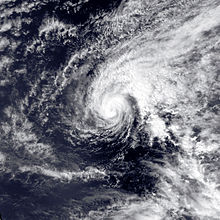

There have been 26 recorded tropical and subtropical cyclones in the North-eastern Pacific basin outside the official Pacific hurricane season. The National Hurricane Center (NHC) monitors the area from North America westward to 140°W, while the Central Pacific Hurricane Center is from 140°W to the International Date Line, north of the equator.[nb 1] The National Oceanic and Atmospheric Administration (NOAA) currently defines the season as starting May 15 in the eastern Pacific and June 1 for the central Pacific and ending on November 30 for both regions in each calendar year.[1] Occasionally, however, storms develop in late November and persist until December.
Few off-season tropical cyclones in the east Pacific have affected land, and none of them have made landfall.[2] Only Hurricane Nina caused both property damage and fatalities. It prompted evacuations in Hawaii and caused $100,000 (1957 USD) in damage in the state.[3] The storm also killed four people and produced 35 ft (10 m) waves.[4] The strongest hurricane between December and May was Hurricane Ekeka in 1992, which reached winds of 115 mph (185 km/h). In 1997, after Tropical Storm Paka crossed the International Date Line, it intensified into a typhoon with winds equivalent to a Category 5 hurricane on the Saffir–Simpson hurricane wind scale, and caused $580 million (1997 USD) in damage in the Marshall Islands, Guam, and the Northern Mariana Islands.[5] The most recent off-season storm is Tropical Storm Andres in mid-May 2021.
The beginning of HURDAT, the official Pacific hurricane database maintained by the NHC, is 1949. Since then, thirteen storms have occurred[2][6] outside the official bounds of hurricane season in the eastern and central north Pacific, respectively.[1] The first storm officially to occur outside of the current season was Hurricane Nina in 1957.[2] In addition, the CPHC reports nine off-season storms from 1900 to 1952 with another off-season tropical cyclone occurring in 1832.[7][8] There have been documents published in the Monthly Weather Review reporting additional off-season storms within 2,000 mi (3,220 km) of the Mexican coastline, including one in December.[9][10] Of all off-season tropical cyclones, the "Froc Cyclone" lasted longest, spanning 12 days and two calendar years.[7] The year with the most off-season storms was tied between 1904 and 1992, with a total of two tropical cyclones. No Pacific hurricane season had both a pre-season and post-season storm.[2][7]
Cite error: There are <ref group=nb> tags on this page, but the references will not show without a {{reflist|group=nb}} template (see the help page).
- ^ a b Dorst, Neal; Hurricane Research Division; Atlantic Oceanographic and Meteorological Laboratory. FAQ: Hurricanes, Typhoons, and Tropical Cyclones Subject: G1) When is hurricane season? (Report). United States National Oceanic and Atmospheric Administration's Office of Oceanic & Atmospheric Research. Archived from the original on 2012-06-25. Retrieved 2010-12-20.
- ^ a b c d National Hurricane Center; Hurricane Research Division; Central Pacific Hurricane Center (April 26, 2024). "The Northeast and North Central Pacific hurricane database 1949–2023". United States National Oceanic and Atmospheric Administration's National Weather Service. Archived from the original on May 29, 2024. A guide on how to read the database is available here.
 This article incorporates text from this source, which is in the public domain.
This article incorporates text from this source, which is in the public domain.
- ^ Central Pacific Hurricane Center (2007). 1957 Central Pacific Hurricane Season Summary (Report). Archived from the original on 2015-07-15. Retrieved 2007-03-08.
- ^ "Ship At Mercy of Hurricane Calls For Help". San Mateo Times. Associated Press. 1957.
- ^ Padgett, Gary; Beven, Jack; Free, James; Delgado Sandy; Hurricane Research Division; Atlantic Oceanographic and Meteorological Laboratory (2011-05-19). "Subject: B3) What storm names have been retired?". United States National Oceanic and Atmospheric Administration's Office of Oceanic & Atmospheric Research. Archived from the original on 2013-11-11. Retrieved 2011-10-17.
- ^ Cite error: The named reference
winonawas invoked but never defined (see the help page). - ^ a b c Central Pacific Hurricane Center. Tropical Cyclones During the Years 1900–1952 (Report). United States National Oceanic and Atmospheric Administration's National Weather Service. Archived from the original on 2015-07-13. Retrieved 2007-01-26.
- ^ Central Pacific Hurricane Center. "Tropical Cyclones in the 1800s". United States National Oceanic and Atmospheric Administration's National Weather Service. Archived from the original on 2012-02-04. Retrieved 2012-06-09.
- ^ Tingley, F. G. (1922). "North Pacific Ocean" (PDF). Monthly Weather Review. 50 (3). United States Weather Bureau: 99. Bibcode:1929MWRv...57..121H. doi:10.1175/1520-0493(1929)57<121:NPO>2.0.CO;2. ISSN 1520-0493. Archived (PDF) from the original on 2012-03-08. Retrieved 2010-12-20.
- ^ Hurd, Willis E. (1929-04-21). "Eastern North Pacific tropical cyclones" (PDF). Monthly Weather Review. 57 (2). United States Weather Bureau: 98. Bibcode:1922MWRv...50...98T. doi:10.1175/1520-0493(1922)50<98:NPO>2.0.CO;2. ISSN 1520-0493. Archived (PDF) from the original on 2007-11-29. Retrieved 2010-12-21.